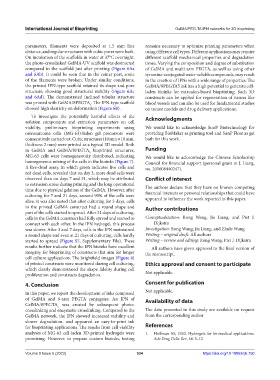Page 542 - IJB-9-5
P. 542
International Journal of Bioprinting GelMA/PEG-TA IPN networks for 3D bioprinting
parameters, filaments were deposited at 1.5 mm line remains necessary to optimize printing parameters when
distance, and regular structures with cubic pores were built. using different cell types. Different applications may require
On incubation of the scaffolds in water at 37°C overnight, different scaffold mechanical properties and degradation
the photo-crosslinked GelMA-UV scaffold was destructed times. Varying the composition and degree of substitution
compared to the scaffold just after printing (Figure 6Aa of GelMA and multi-arm PEGTA, as well as using other
and 6Ab). It could be seen that in the center part, some tyramine-conjugated water-soluble compounds, may result
of the filaments were broken. Under similar conditions, in the creation of IPNs with a wide range of properties. The
the printed IPN-type scaffold retained its shape and pore GelMA/8PEGTA5 ink has a high potential to generate cell-
structure, showing good structural stability (Figure 6Ac laden bioinks for extrusion-based bioprinting. Such 3D
and 6Ad). The demonstrated inclined tubular structure constructs can be applied for regeneration of tissues like
was printed with GelMA/8PEGTA . The IPN-type scaffold blood vessels and can also be used for fundamental studies
5
showed high elasticity on deformation (Figure 6B). on tumor models and drug delivery applications.
To investigate the potentially harmful effects of the
solution components and extrusion parameters on cell Acknowledgments
viability, preliminary bioprinting experiments using We would like to acknowledge SunP Biotechnology for
osteosarcoma cells (MG-63)-laden gel precursors were providing BioMaker as printing tool and SunP Float as gel
consecutively carried out. Cubic structures (10 mm × 10 mm, bath for this work.
thickness 2 mm) were printed as a typical 3D model. Both
in GelMA and GelMA/8PEGTA bioprinted structures, Funding
5
MG-63 cells were homogeneously distributed, indicating We would like to acknowledge the Chinese Scholarship
homogeneous mixing of the cells in the bioinks (Figure 7). Council for financial support (personal grant to J. Liang,
A live-dead assay, in which green indicates live cells and no. 201608440247).
red dead cells, revealed that on day 3, more dead cells were
observed than on days 7 and 21, which may be attributed Conflict of interest
to extrusion stress during printing and the long operational The authors declare that they have no known competing
time due to physical gelation of the GelMA. However, after
culturing for 7 and 21 days, around 90% of the cells were financial interests or personal relationships that could have
alive. It was also noted that after culturing for 3 days, cells appeared to influence the work reported in this paper.
in the printed GelMA construct had a round shape and Author contributions
part of the cells started to spread. After 21 days of culturing,
cells in the GelMA construct had fully spread and started to Conceptualization: Rong Wang, Jia Liang, and Piet J.
connect with each other. In the IPN hydrogel, this process Dijkstra
was slower. After 3 and 7 days, cells in the IPN maintained Investigation: Rong Wang, Jia Liang, and Zhule Wang
a round shape and even at 21 days of culturing, cells hardly Writing – original draft: All authors
started to spread (Figure S7, Supplementary File). These Writing – review and editing: Rong Wang, Piet J. Dijkstra
results further indicate that the IPN bioinks have excellent All authors have given approval to the final version of
integrity for bioprinting of constructs that aim for longer the manuscript.
cell culture applications. The brightfield images (Figure 8)
of printed constructs were monitored during cell culturing, Ethics approval and consent to participate
which clearly demonstrated the shape fidelity during cell
proliferation and constructs degradation. Not applicable.
4. Conclusion Consent for publication
In this paper, we report the development of inks composed Not applicable.
of GelMA and 8-arm PEGTA conjugates. An IPN of Availability of data
GelMA/8PEGTA was created by subsequent photo-
5
crosslinking and enzymatic crosslinking. Compared to the The data presented in this study are available on request
GelMA network, the IPN showed increased stability and from the corresponding author.
slower degradation, and appeared an easy-to-print ink
for bioprinting applications. The results from cell viability References
analyses of MG-63 cell-laden 3D-printed hydrogels were 1. Hoffman AS, 2002, Hydrogels for biomedical applications.
promising. However, to prepare custom bioinks, testing Adv Drug Deliv Rev, 54: 3–12.
Volume 9 Issue 5 (2023) 534 https://doi.org/10.18063/ijb.750

